PR
X
Keyword Search
▼キーワード検索
Comments
続日本100名城東北の…
New!
オジン0523さん
【甥のステント挿入… New!
Gママさん
New!
Gママさん
2025年版・岡山大学… New!
隠居人はせじぃさん
New!
隠居人はせじぃさん
ムベの実を開くコツ… noahnoahnoahさん
noahnoahnoahさん
エコハウスにようこそ ecologicianさん
【甥のステント挿入…
 New!
Gママさん
New!
Gママさん2025年版・岡山大学…
 New!
隠居人はせじぃさん
New!
隠居人はせじぃさんムベの実を開くコツ…
 noahnoahnoahさん
noahnoahnoahさんエコハウスにようこそ ecologicianさん
Calendar
カテゴリ: 海外旅行
【 海外旅行 ブログリスト
】👈️リンク
この日は6月9日(月)、この アイルランド・ロンドンへの旅の最終日 、そしてもちろんロンドンの
散策も最終日。元気に起床し帰国に向けてパッケージングも完了。
私のこの日の夜のロンドン・ヒースロー空港からの帰国便は、
中国国際航空・CA912便・20:25発 で北京にてトランジットして羽田への予定。
我が宿泊のアパートメントのチェックアウトは10時とのことで、トランクを何処に預けて
ロンドン最終日を楽しむか?
Victoria and Albert Museum・ヴィクトリア&アルバート博物館は 、大きなトランクを預けての
したのであった。

朝食を済ませ、9:20にアパートを出発。我が宿泊アパートは正面入口の右の門の右にある
黒いアルミフェンスのドアの奥の半地階の部屋。
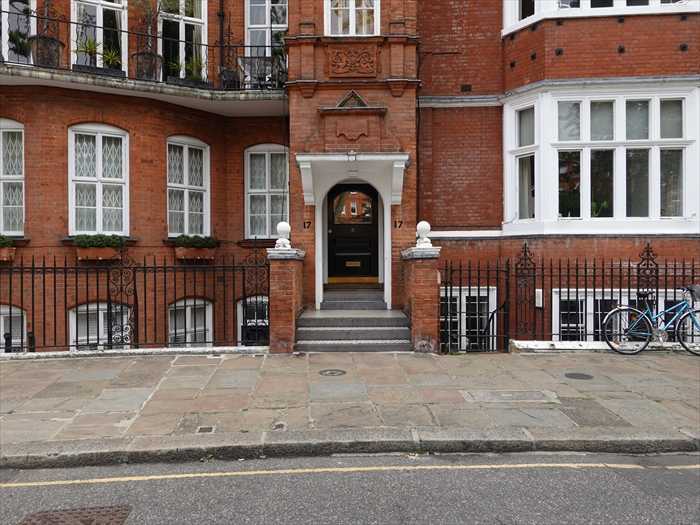
近づいて。 写真右のフェンスドアが地階への入口 。
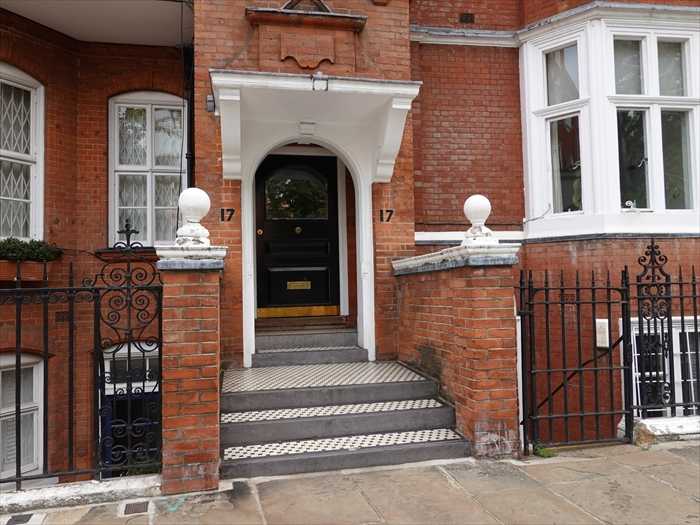
青いドアが半地階にある我々の宿の部屋への入口。
まるで、誰かが居住している様な宿なのであった。
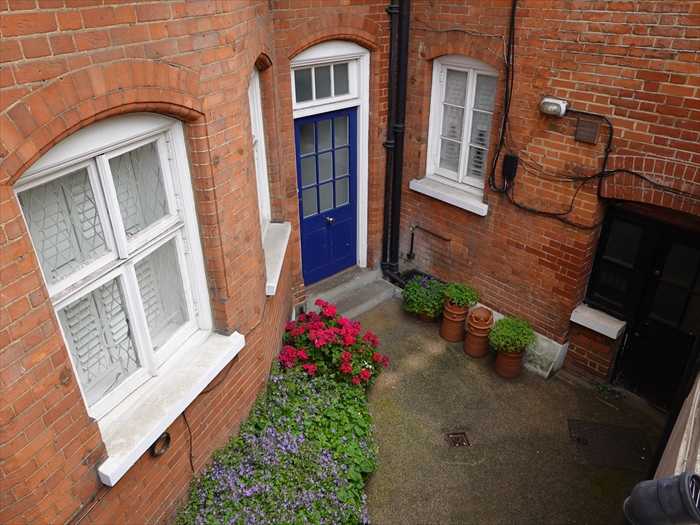
Walton St、エガートンテラスを進み、Brompton Roadに出て左折し、
Victoria and Albert Museum・ヴィクトリア&アルバート博物館 に向かって
トランクを転がしながら進む。
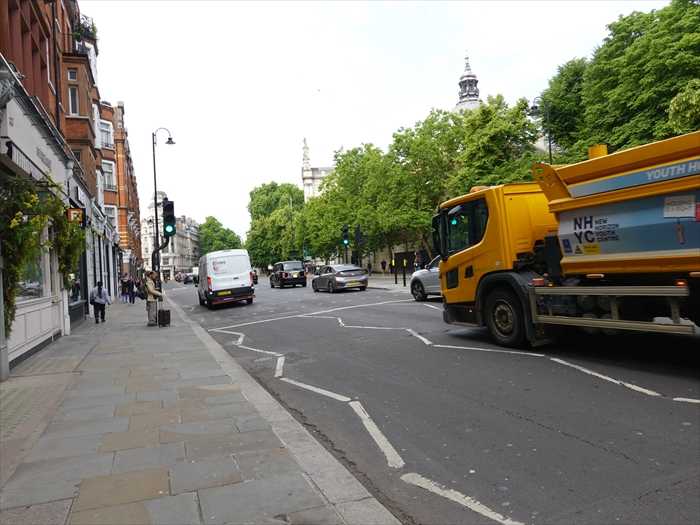
右手前方に見えたのが、カトリック教会の The Brompton Oratory・ロンドン・オラトリーの
ドーム 。
この日は6月9日(月)、この アイルランド・ロンドンへの旅の最終日 、そしてもちろんロンドンの
散策も最終日。元気に起床し帰国に向けてパッケージングも完了。
私のこの日の夜のロンドン・ヒースロー空港からの帰国便は、
中国国際航空・CA912便・20:25発 で北京にてトランジットして羽田への予定。
我が宿泊のアパートメントのチェックアウトは10時とのことで、トランクを何処に預けて
ロンドン最終日を楽しむか?
Victoria and Albert Museum・ヴィクトリア&アルバート博物館は 、大きなトランクを預けての
したのであった。

朝食を済ませ、9:20にアパートを出発。我が宿泊アパートは正面入口の右の門の右にある
黒いアルミフェンスのドアの奥の半地階の部屋。

近づいて。 写真右のフェンスドアが地階への入口 。

青いドアが半地階にある我々の宿の部屋への入口。
まるで、誰かが居住している様な宿なのであった。

Walton St、エガートンテラスを進み、Brompton Roadに出て左折し、
Victoria and Albert Museum・ヴィクトリア&アルバート博物館 に向かって
トランクを転がしながら進む。

右手前方に見えたのが、カトリック教会の The Brompton Oratory・ロンドン・オラトリーの
ドーム 。
建物の概要
・正式名称: Church of the Immaculate Heart of Mary (聖母の汚れなき御心教会)
・通称: The Brompton Oratory(ブロンプトン・オラトリー)
・所在地: ロンドン、サウス・ケンジントン地区(地下鉄サウス・ケンジントン駅すぐ)
・建設: 1884年完成、19世紀後半の壮大なバロック様式のカトリック教会。
特徴
・ロンドンにおけるカトリック教会の中心的存在の一つ。
・大きなドームとバロック風の華やかな内部装飾が特徴。
・聖歌隊(Oratory Choir)の水準が非常に高く、音楽面でも有名。
・隣接して「ロンドン自然史博物館」「ヴィクトリア&アルバート博物館」などがあり、
文化ゾーンの一角をなしていた。
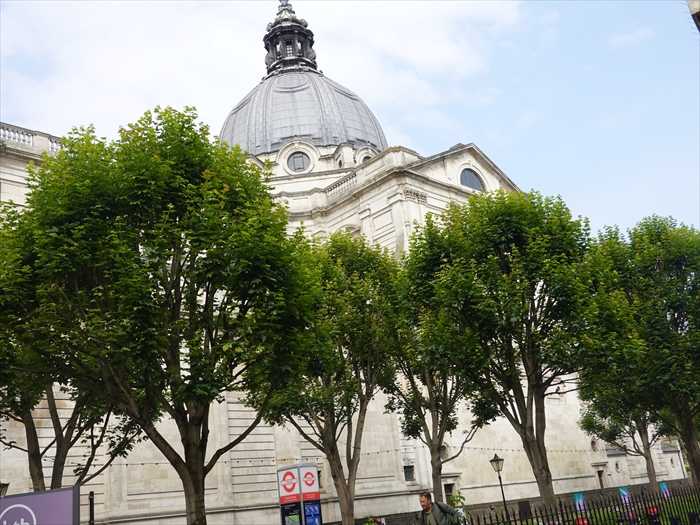
右手の細い道路沿いにあったのが 「 The Return of the Prodigal(放蕩息子の帰還) 」像。
・場所: London Oratory(ロンドン・オラトリー/Brompton Oratory)前の道路沿い
・主題: 聖書「ルカによる福音書 15章」の「放蕩息子のたとえ」に基づき、父が息子を
抱きしめる姿を表現。
・設置場所: ロンドン・オラトリー(Brompton Oratory)前の屋外。
・特徴:
・粗い表面のブロンズ彫刻で、人間の弱さや悔い改めを象徴。
文化ゾーンの一角をなしていた。

右手の細い道路沿いにあったのが 「 The Return of the Prodigal(放蕩息子の帰還) 」像。
・場所: London Oratory(ロンドン・オラトリー/Brompton Oratory)前の道路沿い
・主題: 聖書「ルカによる福音書 15章」の「放蕩息子のたとえ」に基づき、父が息子を
抱きしめる姿を表現。
・設置場所: ロンドン・オラトリー(Brompton Oratory)前の屋外。
・特徴:
・粗い表面のブロンズ彫刻で、人間の弱さや悔い改めを象徴。
・同時に、父の抱擁は神の無条件の愛と赦しを示す。
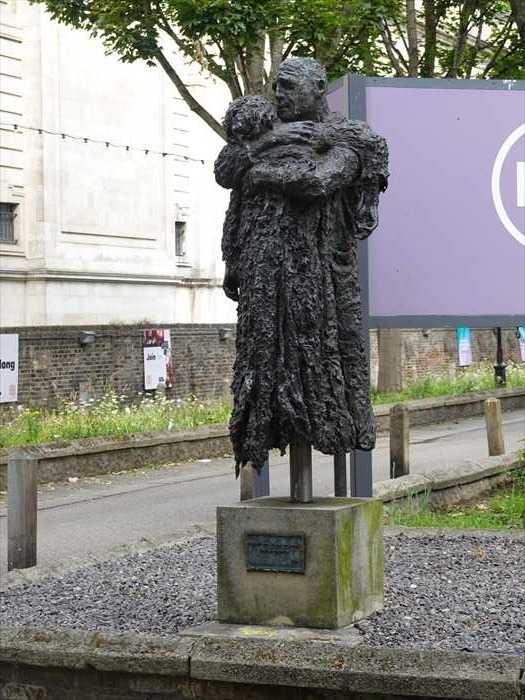
銘板の文字は
「THE RETURN OF THE PRODIGALCHARLIE MACKESY 2005」
【『 放蕩息子の帰還 』チャーリー・マッケジー 2005年】
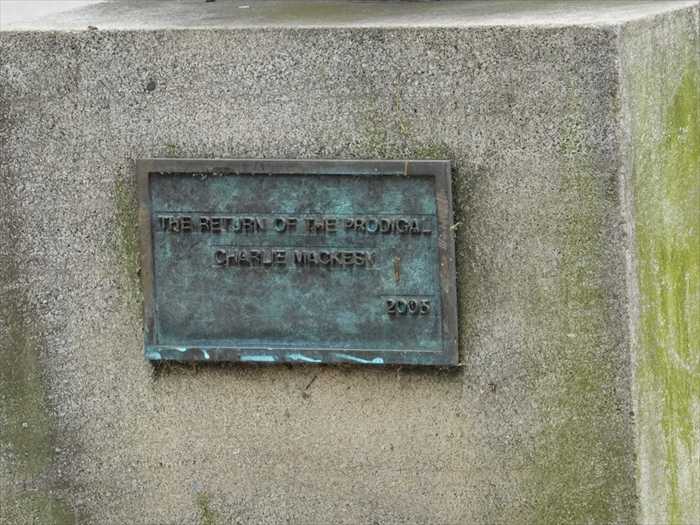
ロンドン・オラトリー(The London Oratory / Brompton Oratory) の正面ファサード。
 17世紀ローマ・バロック様式に範をとった正面構成。特にイエズス会の母教会
17世紀ローマ・バロック様式に範をとった正面構成。特にイエズス会の母教会
「サンタンドレア・デッラ・ヴァッレ(ローマ)」や「イル・ジェズ教会」の影響を
色濃く受けています。
・正面構成:
・下層は列柱を伴ったポルチコ(玄関ポーチ)。
・上層は三角破風と装飾的レリーフを持つクラシカルな構成。
・壁面には丸窓や飾り窓枠(ペディメント付き)が並び、バロック特有の重厚さと
リズム感を演出。
・素材: 白いポートランド石が使われ、威厳と清浄さを強調。
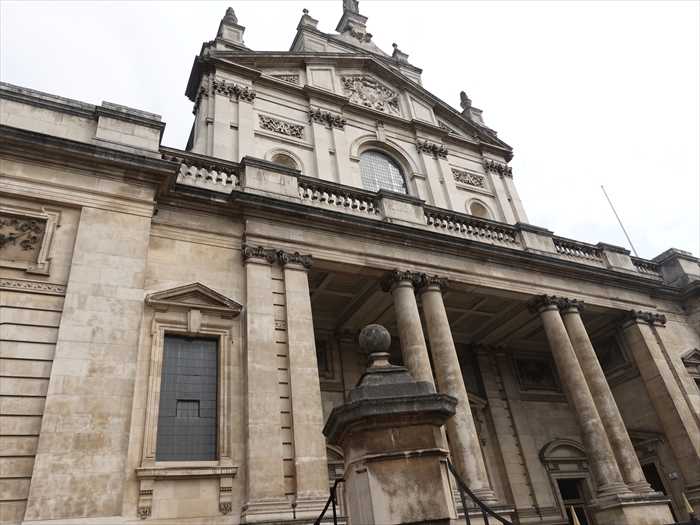

銘板の文字は
「THE RETURN OF THE PRODIGALCHARLIE MACKESY 2005」
【『 放蕩息子の帰還 』チャーリー・マッケジー 2005年】

ロンドン・オラトリー(The London Oratory / Brompton Oratory) の正面ファサード。
「サンタンドレア・デッラ・ヴァッレ(ローマ)」や「イル・ジェズ教会」の影響を
色濃く受けています。
・正面構成:
・下層は列柱を伴ったポルチコ(玄関ポーチ)。
・上層は三角破風と装飾的レリーフを持つクラシカルな構成。
・壁面には丸窓や飾り窓枠(ペディメント付き)が並び、バロック特有の重厚さと
リズム感を演出。
・素材: 白いポートランド石が使われ、威厳と清浄さを強調。

これはロンドンの Brompton Oratory(ブロンプトン・オラトリー/正式名:ロンドン・
オラトリー教会) に付属する Newman Shrine(ニューマン記念碑)。
バロック風の記念建築で、壁面に大きく迫り出した祠堂(ニッチ)を設け、その中に
ニューマン像を配置。さらにその上に聖母子像を載せていた。

ロンドン・オラトリー(Brompton Oratory / The London Oratory) の入口の手前に
設置されていたこの建築的な「二層構造」の彫刻配置では、下段にジョン・ヘンリー・
ニューマン枢機卿像(1801–1890)が据えられており、その上部に「守護・象徴像」が
配置されていた。

最上部の像は、 聖母子像・Madonna and Child 。

JOHN HENRY CARDINAL NEWMAN 像。

JOHN HENRY CARDINAL NEWMAN(ジョン・ヘンリー・ニューマン枢機卿)像 をズームして。

ロンドン・オラトリー(The London Oratory / Brompton Oratory) を振り返って。

そしてトランクを転がしながら最初の目的地の
Victoria and Albert Museum・ヴィクトリア&アルバート博物館 前に到着。
オラトリー教会) に付属する Newman Shrine(ニューマン記念碑)。
バロック風の記念建築で、壁面に大きく迫り出した祠堂(ニッチ)を設け、その中に
ニューマン像を配置。さらにその上に聖母子像を載せていた。

ロンドン・オラトリー(Brompton Oratory / The London Oratory) の入口の手前に
設置されていたこの建築的な「二層構造」の彫刻配置では、下段にジョン・ヘンリー・
ニューマン枢機卿像(1801–1890)が据えられており、その上部に「守護・象徴像」が
配置されていた。

最上部の像は、 聖母子像・Madonna and Child 。
・ 女性像が子ども(幼児)を抱いている
。
・ 子どもは左腕に抱えられており、母(聖母マリア)がやや身体を支えるように立っている姿勢
。
・ドレープ(衣のひだ)が豊かに表現され、母性的な落ち着いた雰囲気を持つ。

JOHN HENRY CARDINAL NEWMAN 像。
1801–1890 。

JOHN HENRY CARDINAL NEWMAN(ジョン・ヘンリー・ニューマン枢機卿)像 をズームして。
・生涯
ジョン・ヘンリー・ニューマン(John Henry Newman, 1801–1890)は、19世紀のイギリスを
代表する神学者・思想家です。もとはイングランド国教会の聖職者でしたが、後にローマ・
カトリックへ改宗しました。
代表する神学者・思想家です。もとはイングランド国教会の聖職者でしたが、後にローマ・
カトリックへ改宗しました。
・業績
・オックスフォード運動の中心人物の一人として知られ、イングランド国教会における伝統と
カトリック的要素の回復を目指しました。
カトリック的要素の回復を目指しました。
・1845年にカトリックへ改宗し、その後枢機卿に叙任されました。
・教育思想や良心論で有名であり、現代のカトリック思想に大きな影響を与えました。
・列聖
ニューマンは2010年に列福され、2019年にローマ教皇フランシスコによって聖人に
列聖されました。
列聖されました。

ロンドン・オラトリー(The London Oratory / Brompton Oratory) を振り返って。

そしてトランクを転がしながら最初の目的地の
Victoria and Albert Museum・ヴィクトリア&アルバート博物館 前に到着。
・所在地: ロンドン、サウス・ケンジントン
・ 創設: 1852年(1851年のロンドン万国博覧会の成果を継承して設立)
・名称由来: ヴィクトリア女王と夫アルバート公にちなんで命名
・特徴: 世界最大級の装飾美術・デザインの博物館。
・所蔵品は約230万点。
・彫刻、陶磁器、ファッション、家具、絵画、金工、写真など多岐にわたる。

Victoria and Albert Museum・ヴィクトリア&アルバート博物館 の航空写真をネットから。

Victoria and Albert Museum・ヴィクトリア&アルバート博物館 入口前から見上げて。
・ 正面中央の大アーチ(ポーチ)は「ポータル」と呼ばれ、細かい彫刻 が施されている。
・ 上部には塔のようなクイーン・メアリー・タワー(Queen Mary’s Tower) がそびえる。
・ ファサードにはヴィクトリア時代の彫刻や装飾モチーフが豊かにあしらわれ 、19世紀末の
折衷主義的なデザインを代表している。

正面玄関上部に掲げられている英国王室の紋章(Royal Coat of Arms )をズームして。

イギリスの国章(Royal Coat of Arms of the United Kingdom) をネットから.

その下、正面玄関(Cromwell Road façade) 上部右側にあった浮彫彫刻(relief sculpture) 。

スパンドレル とは 3 角形の空白 で、通常は次のような 場所に汲みになって見いだされる。
アーチの上部と長方形の枠の間、 隣接する 2 つのアーチの上部 と。
その内部の円の間の 4 スミの1つである。 これらは、しばしば装飾的な要素で満たされている と。
下記写真はネットから。

その下、正面ファサードの 女王像群 。
ヴィクトリア&アルバート博物館(Victoria and Albert Museum, V&A)
正面入口の大アーチ部分 。
中央像
・アーチの中央、入口扉の真上に立つ像は 聖ゲオルギウス(St George) 。

Victoria and Albert Museum・ヴィクトリア&アルバート博物館 の航空写真をネットから。

Victoria and Albert Museum・ヴィクトリア&アルバート博物館 入口前から見上げて。
・ 正面中央の大アーチ(ポーチ)は「ポータル」と呼ばれ、細かい彫刻 が施されている。
・ 上部には塔のようなクイーン・メアリー・タワー(Queen Mary’s Tower) がそびえる。
・ ファサードにはヴィクトリア時代の彫刻や装飾モチーフが豊かにあしらわれ 、19世紀末の
折衷主義的なデザインを代表している。

正面玄関上部に掲げられている英国王室の紋章(Royal Coat of Arms )をズームして。
1. 盾(中央)
盾は四分割され、イギリス連合王国を構成する王国を象徴しています:
・左上・右下:3頭の獅子(England)
・右上:獅子 rampant(立ち上がる獅子)(Scotland)
・左下:ハープ(Ireland)
2. 支持者(Supporters)
・左(向かって右側):獅子(Lion)
イングランドを象徴し、王権・勇気・威厳を表す。王冠をかぶっています。
・右(向かって左側):一角獣(Unicorn)
スコットランドを象徴。純潔と力の制御を意味し、鎖でつながれているのは
「力を制御している」ことの象徴。
「力を制御している」ことの象徴。
3. モットー(Motto)
上部と下部にラテン語とフランス語の語句が刻まれています:
・上部(環状帯に刻まれた文字)
“HONI SOIT QUI MAL Y PENSE”
意味:「それを悪く思う者に災いあれ」
─ イングランド最高位の勲章「ガーター勲章(Order of the Garter)」の標語である と。
・下部(リボン部)
“DIEU ET MON DROIT”
意味:「神と我が権利」
─ イングランド王のモットーであり、王権神授説(divine right of kings)を象徴 と。

イギリスの国章(Royal Coat of Arms of the United Kingdom) をネットから.
この紋章は、イギリス王室の統一と正統性を象徴しています。
・ライオンとユニコーン → イングランドとスコットランドの連合
・ライオンとユニコーン → イングランドとスコットランドの連合
・四分割の盾 → イングランド、スコットランド、アイルランドの統合
・モットー → 王権の神聖と栄誉の理念

その下、正面玄関(Cromwell Road façade) 上部右側にあった浮彫彫刻(relief sculpture) 。
この(右側スパンドレル)の場面は、
女性像が建物模型(V&A館)を差し出す構図で、
「Art(芸術)」が「Architecture(建築)」に博物館を授ける寓意。


この(左側スパンドレル)の場面は、
「知識(学問)によって導かれる労働(技術)」というヴィクトリア朝の理想主義を象徴。
V&Aの設立理念 ― すなわち Art and Science united for the improvement of industry
(産業発展のための芸術と科学の融合)を視覚的に示しているのだ と。
V&Aの設立理念 ― すなわち Art and Science united for the improvement of industry
(産業発展のための芸術と科学の融合)を視覚的に示しているのだ と。
・左の女性像:知識(Knowledge)の擬人像。
書物や巻物を手にしており、教育・学問・知恵を象徴。
・右の男性像:労働(Labour)の象徴。
筋骨逞しい姿で、手には工具を持つなど、実践的な技術や生産を表す。

スパンドレル とは 3 角形の空白 で、通常は次のような 場所に汲みになって見いだされる。
アーチの上部と長方形の枠の間、 隣接する 2 つのアーチの上部 と。
その内部の円の間の 4 スミの1つである。 これらは、しばしば装飾的な要素で満たされている と。
下記写真はネットから。

その下、正面ファサードの 女王像群 。
中央像
・ ヴィクトリア女王(Queen Victoria, 1819–1901)
・王冠を戴き、右手に王笏(Sceptre)、左手に宝珠(Orb)を持っています。
・王権の正統性と大英帝国の君主としての威厳を象徴。
・台座には「VICTORIA」と刻まれています。
両脇の像
・左側と右側には、黄金の剣を携えた 二体の武人像(守護像)
。
・実際には「忠誠」「守護」「正義」を寓意的に表す戦士像で、女王を護る存在として
配置されています。
配置されています。
・鎧姿に身を固め、手にする剣が象徴的に金色で強調されているのが特徴。
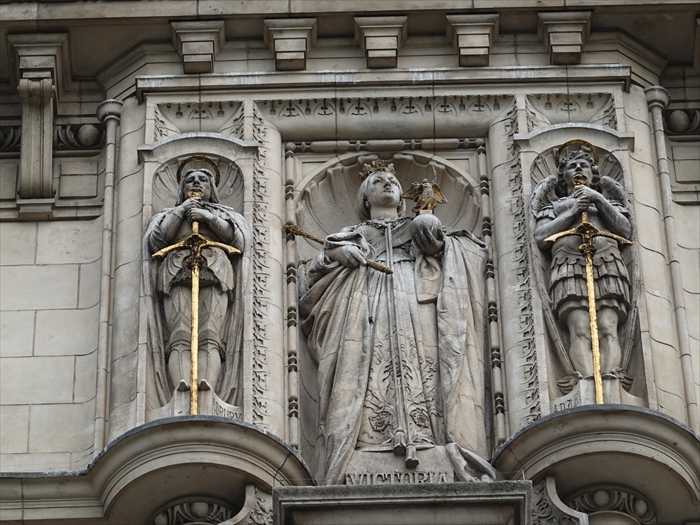

ヴィクトリア&アルバート博物館(Victoria and Albert Museum, V&A)
正面入口の大アーチ部分 。
中央像
・アーチの中央、入口扉の真上に立つ像は 聖ゲオルギウス(St George) 。
・イングランドの守護聖人で、竜を退治する伝説で有名。
・国の守護と博物館の象徴的守護を兼ねてここに置かれています。
・国の守護と博物館の象徴的守護を兼ねてここに置かれています。
アーチの装飾
・アーチ内側の小彫刻群
アーチの層ごとに小さなレリーフ像がぎっしりと配置されており、それぞれが 芸術や産業に
関わる寓意像・職人像・知識人像 を表しています。
関わる寓意像・職人像・知識人像 を表しています。
・上部の三角形破風(ティンパヌム)部分
より大きな群像彫刻があり、「芸術と学問を通じて人類を高める」という象徴的場面を
表現しています。
表現しています。
・両脇の柱や壁龕
装飾的な円柱と人物像のニッチ(壁龕)が並び、全体を荘厳にまとめています。
この正面玄関は 1909年完成。設計者は Sir Aston Webb(サー・アストン・ウェッブ)。
彼はロンドンのバッキンガム宮殿改修も手がけた建築家で、新古典主義的で荘厳な正面を
設計した と。

正面玄関(Cromwell Road Entrance)右側に設置されている
記念銘板(foundation stone plaque) 。
「THIS STONE WAS LAID BY HER MAJESTY QUEEN VICTORIA
設計した と。

正面玄関(Cromwell Road Entrance)右側に設置されている
記念銘板(foundation stone plaque) 。
「THIS STONE WAS LAID BY HER MAJESTY QUEEN VICTORIA
EMPRESS OF INDIA ON THE 17TH DAY OF MAY 1899 IN THE
63RD YEAR OF HER REIGN FOR THE COMPLETION OF THE
SOUTH KENSINGTON MUSEUM INAUGURATED BY HIS
ROYAL HIGHNESS THE PRINCE CONSORT AND HENCEFORTH
TO BE KNOWN AS THE VICTORIA AND ALBERT MUSEUM」
【この石は、インド女帝 ヴィクトリア女王陛下 により
【この石は、インド女帝 ヴィクトリア女王陛下 により
1899年5月17日、彼女の治世第63年に据えられた。
この日、殿下 プリンス・コンソート(アルバート公) によって開設された
サウス・ケンジントン博物館 の完成を記念し、
これ以後、この館は 「ヴィクトリア&アルバート博物館」 として
知られることとなった。】
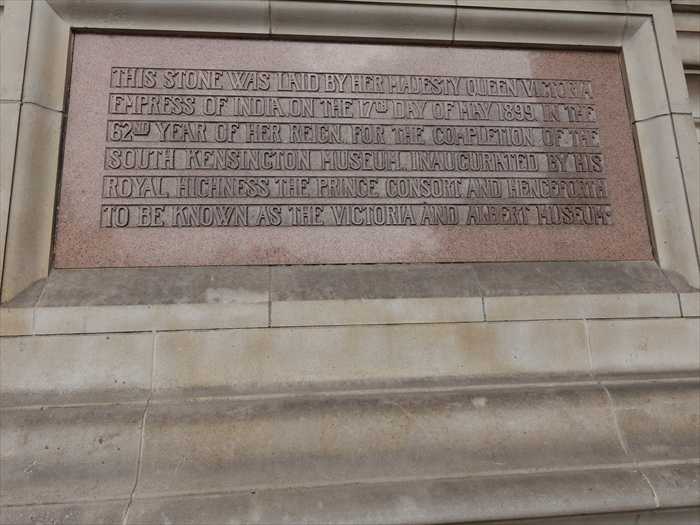
【この建物、すなわち ヴィクトリア&アルバート博物館の完成部分 は、
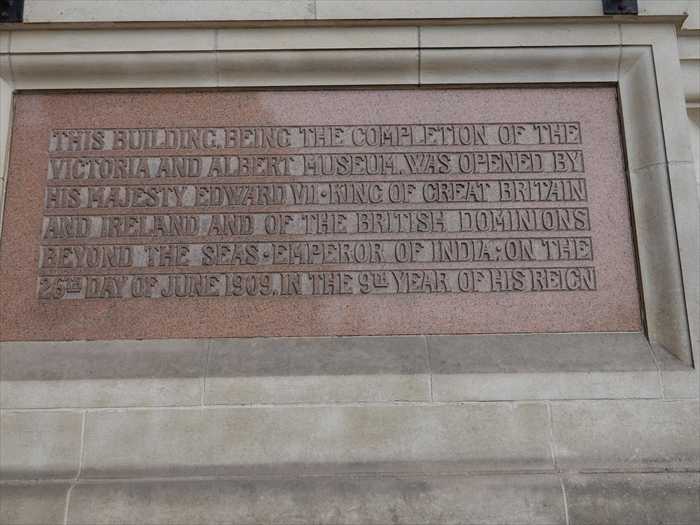
正面入口の中央像をクローズアップして。

左側の 記念銘板(foundation stone plaque)
には博物館の正式名称が
「 Victoria and Albert Museum 」となった経緯が記載されていた。
「THIS BUILDING BEING THE COMPLETION OF THE 「 Victoria and Albert Museum 」となった経緯が記載されていた。
VICTORIA AND ALBERT MUSEUM, WAS OPENED BY
HIS MAJESTY EDWARD VII, KING OF GREAT BRITAIN
AND IRELAND AND OF THE BRITISH DOMINIONS
BEYOND THE SEAS, EMPEROR OF INDIA, ON THE
26TH DAY OF JUNE 1909, IN THE 9TH YEAR OF HIS REIGN」 【この建物、すなわち ヴィクトリア&アルバート博物館の完成部分 は、
大英帝国およびアイルランド国王、並びに海外領土の王にしてインド皇帝である
エドワード7世陛下 により、
1909年6月26日、彼の治世第9年に開館された。】エドワード7世陛下 により、

正面入口の中央像をクローズアップして。
・像の台座に 「ALBERT」 と刻まれている通り、この像は
アルバート公(Prince Albert, 1819–1861) 。
アルバート公(Prince Albert, 1819–1861) 。
・アルバート公はヴィクトリア女王の夫であり、芸術・科学・教育の振興に大きな役割を
果たした。
果たした。
・彼は1851年の ロンドン万国博覧会(The Great Exhibition) を主導し、その収益がこの博物館
(当初はサウス・ケンジントン博物館)の設立につながっている と。
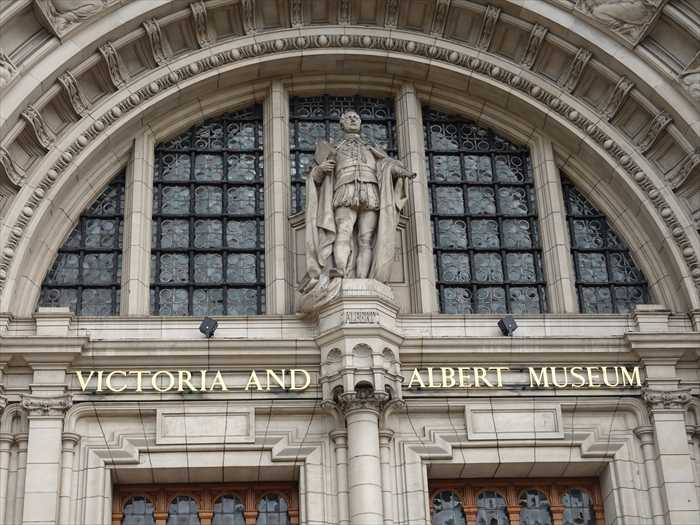
姿勢: 堂々と立ち、右手で書物(または巻物)を持ち、左手を広げて人々を導くような仕草。
(当初はサウス・ケンジントン博物館)の設立につながっている と。

姿勢: 堂々と立ち、右手で書物(または巻物)を持ち、左手を広げて人々を導くような仕草。
服装:
ルネサンス風の装束にマントを羽織り、文化の庇護者・芸術の守護者として
理想化されている。
理想化されている。
表情:
正面を見据え、未来を見通すような厳粛な表情。
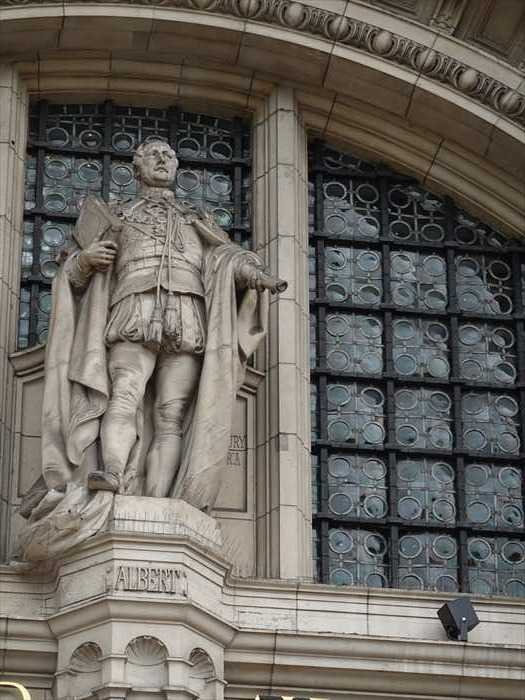
見上げて。

ヴィクトリア&アルバート博物館(Victoria and Albert Museum, V&A) の側面
(Exhibition Road 側のファサード)を振り返って。

見上げて。

ヴィクトリア&アルバート博物館(Victoria and Albert Museum, V&A) の側面
(Exhibition Road 側のファサード)を振り返って。
・左手前の建物部分:
アーチ型の窓や装飾が並び、19世紀の折衷主義建築らしい重厚な外観。
・右奥に見える赤レンガと白石のストライプ模様の塔:
これは隣接する ロンドン・オラトリー (Brompton Oratory) の塔。
これは隣接する ロンドン・オラトリー (Brompton Oratory) の塔。
・特徴的な赤白のストライプとドーム屋根は、オラトリーの外観を象徴する要素。
・バナー(Cartier展):
博物館で行われた特別展の告知バナー。V&Aはファッション・宝飾・
デザインの展示でも世界的に知られています。
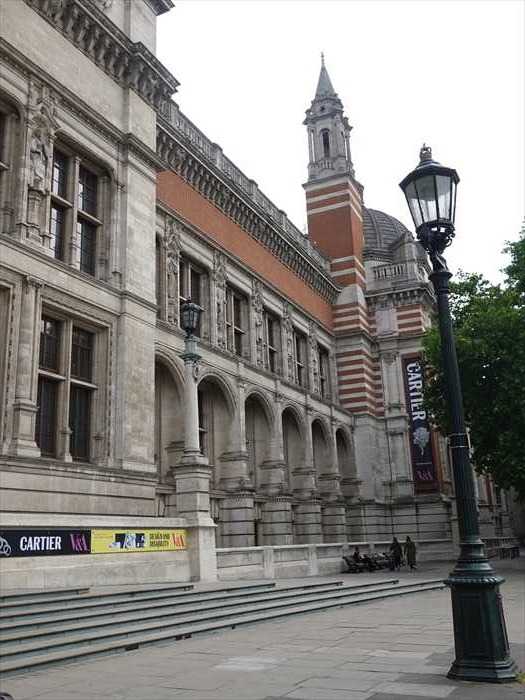
入館案内 。
「 Welcome
【 ようこそ

ヴィクトリア&アルバート博物館(Victoria and Albert Museum, V&A) 👈️リンクの
館内ディレクトリ(館内案内板) 。
デザインの展示でも世界的に知られています。

入館案内 。
「 Welcome
Open
10:00 – 17:45 daily
10:00 – 22:00 Friday
Closed 24 – 26 December
Exhibition Road doors close at 17:45 daily
Admission free
Admission free
Some exhibitions and events carry a separate charge
Galleries may be closed occasionally without prior notice
CCTV is in operation throughout the V&A
For more information, call 020 7942 2000 or visit vam.ac.uk
The V&A’s conditions of entry apply throughout the building」【 ようこそ
開館時間
・毎日 10:00 – 17:45
・金曜日 10:00 – 22:00
・12月24日~26日は休館
・Exhibition Road 側の入口は毎日 17:45 に閉鎖
入館料
・無料
・一部の特別展やイベントは別途有料
(補足)
(補足)
・ギャラリーは予告なく閉鎖される場合があります
・館内ではCCTV(監視カメラ)を稼働中です
・詳細は 020 7942 2000 へ電話、または vam.ac.uk を参照
・V&A の入館条件は建物全体に適用されます】
ヴィクトリア&アルバート博物館(Victoria and Albert Museum, V&A) 👈️リンクの
館内ディレクトリ(館内案内板) 。
・階層(LEVELS)
・-1階(Basement):
一部の展示室・施設
・0階(Ground floor):
正面入口、大中庭、主要なギャラリーへの入口
・1階(Level 1):
彫刻・装飾美術・地域別ギャラリー
・2階(Level 2):
ファッション、織物、家具など
・3階(Level 3):
写真、図書館、特別展示スペースなど
・4階(Level 4):
特別展示、デザイン関連
・Exhibitions(特別展)
・0階: Design and Disability(デザインと障害)
・1階: Cartier(カルティエ展)
・Facilities(施設案内)
・インフォメーション
・トイレ
・カフェ・レストラン
・ショップ
・エレベーター/階段
Galleries(ギャラリー一覧)
右側にリスト化され、館内各フロアの主要展示(例: Sculpture, Fashion, Jewellery, Furniture,
Asia, Europe, Medieval & Renaissance など)が並んでいます。
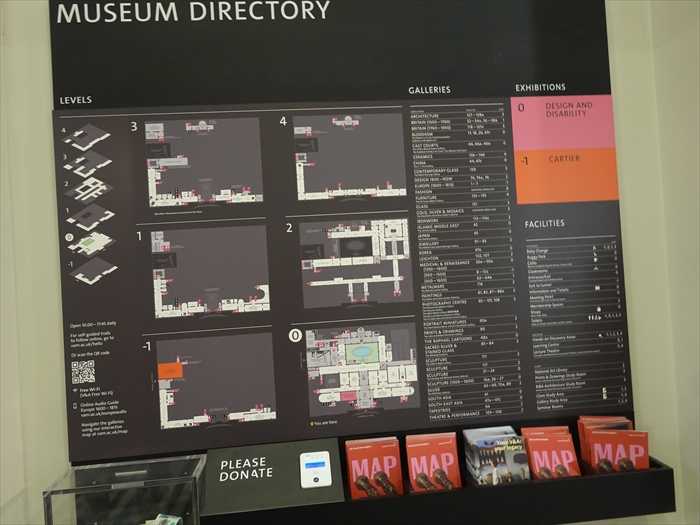
ズームして。
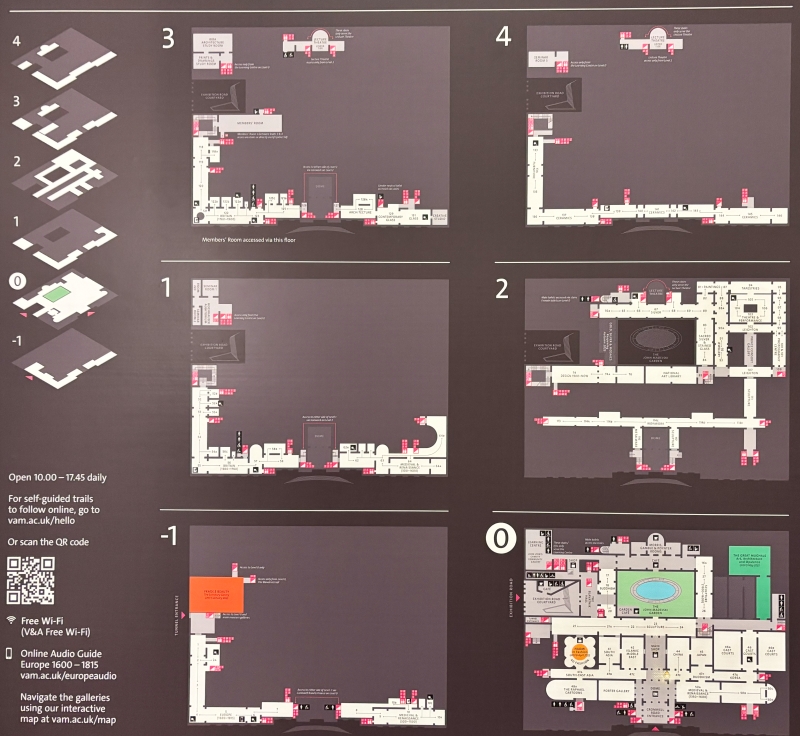
館内図をネットから。

0階の配置案内図 👈️リンク をネット写真をトリミングして。

正面ホール(Grand Entrance Hall) の吹き抜け部分 。
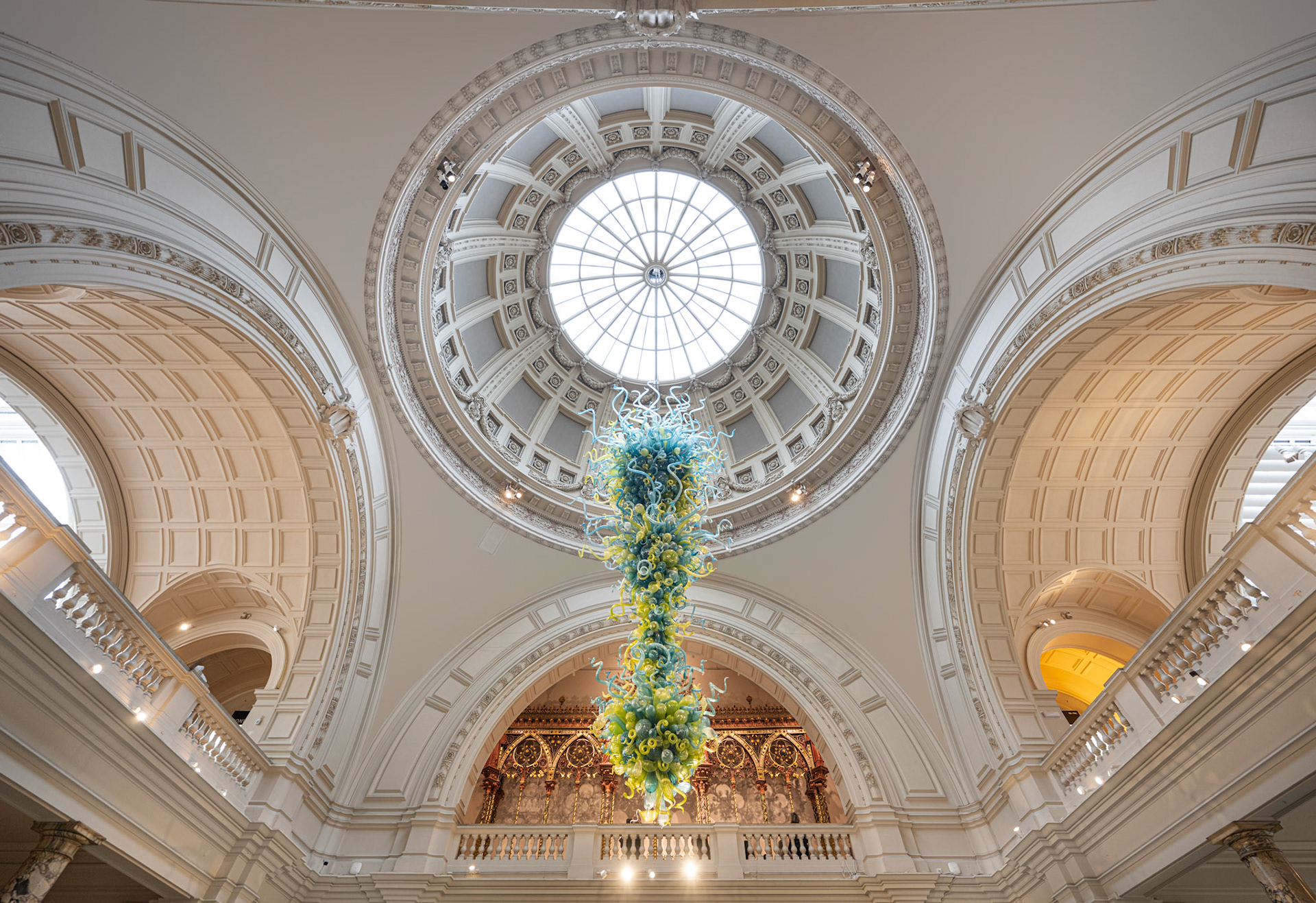
・天井のドームから吊り下げられているガラスのシャンデリアは、アメリカの現代ガラス作家
デイル・チフーリ(Dale Chihuly, 1941– ) の作品。
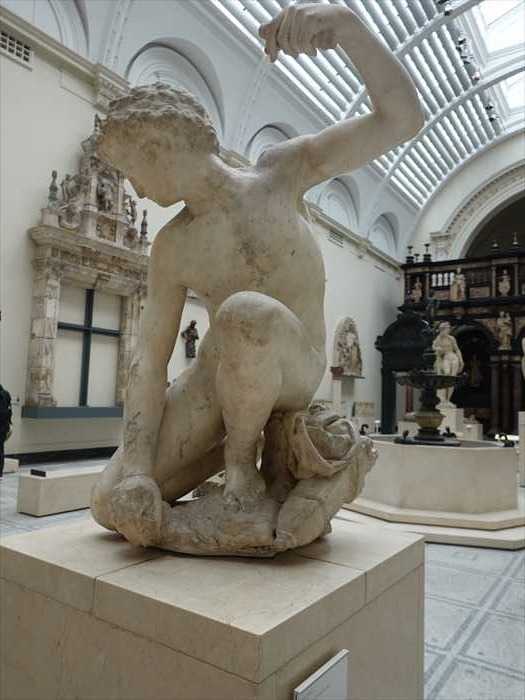
「 NARCISSUS
【 ナルキッソス
約1560年
ヴァレリオ・チョリ(1529–1599頃)作の可能性
ルネサンス期には、古代ローマの彫刻を再加工することがよく行われました。
この像《ナルキッソス》も長らくその一例と考えられていましたが、現在では彫刻家で修復家でも
あったヴァレリオ・チョリによって制作された可能性があるとされています。
ギリシャ神話によれば、ナルキッソスは水面に映る自分の姿に恋をしたと伝えられています。
この神話は庭園彫刻の題材として非常にふさわしいものでした。
イタリア(おそらくフィレンツェ)
大理石
19世紀に石膏による修復あり
館蔵番号 7560-1861 】

・・・ もどる ・・・
・・・ つづく ・・・
Asia, Europe, Medieval & Renaissance など)が並んでいます。

ズームして。

館内図をネットから。

0階の配置案内図 👈️リンク をネット写真をトリミングして。

正面ホール(Grand Entrance Hall) の吹き抜け部分 。

・天井のドームから吊り下げられているガラスのシャンデリアは、アメリカの現代ガラス作家
デイル・チフーリ(Dale Chihuly, 1941– ) の作品。
・作品名は 「 Rotunda Chandelier(ロタンダ・シャンデリア)
」。
・2001年に設置され、その後2005年に再設計されて現在の形に近づきました。
・鮮やかなブルーやグリーンのガラスが渦巻くように絡み合い、生命力と流動感を感じさせます。
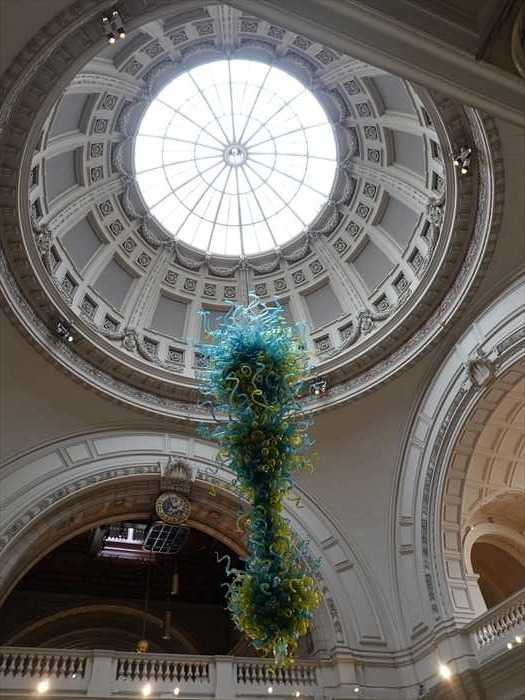
・ガラスの色彩:

・ガラスの色彩:
・青(ブルー)と緑(グリーン)を基調とし、黄色がアクセント。
・自然光を受けると透明感が増し、まるで水中植物や海の渦潮のように輝きます。
・形態:
・無数のガラスの触手状パーツが螺旋を描き、エネルギーの爆発や生命の成長を象徴。
・下方に向けてすぼまる形が、訪問者の視線を自然に中央へ導きます。
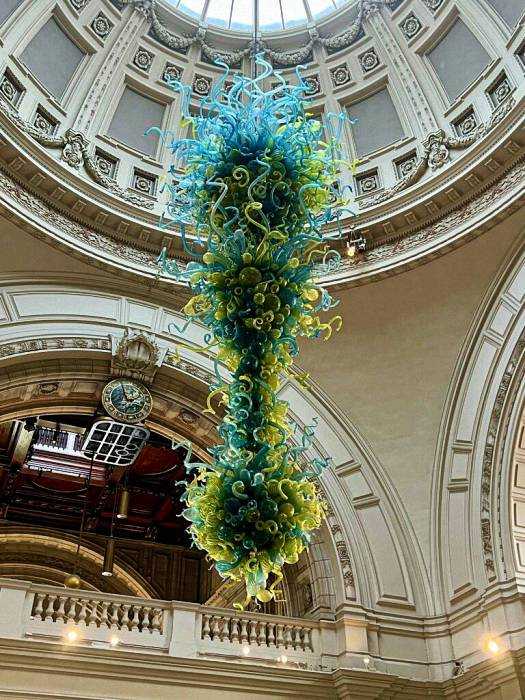
移動して。

ズームして。
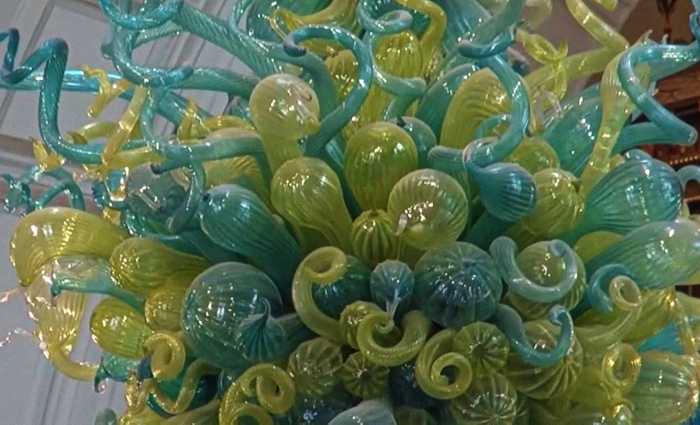
正面ホール(Grand Entrance Hall)の インフォメーション・デスク。
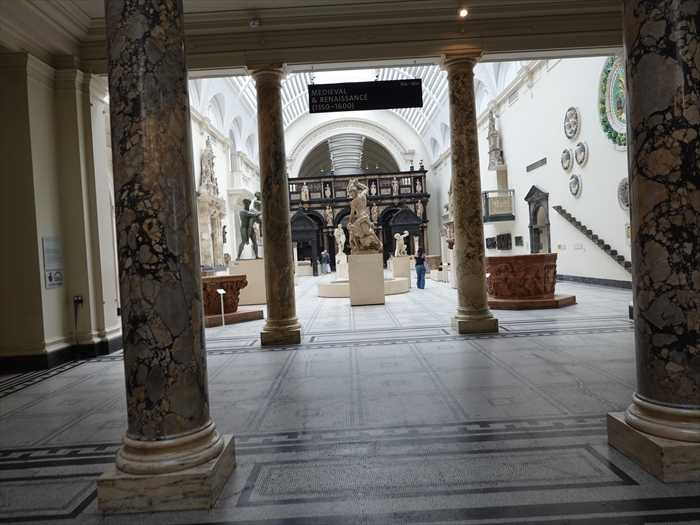
「Medieval & Renaissance (1350–1600)」ギャラリー(50A–50D) の入口 標識。
・Medieval & Renaissance (1350–1600)
に展示されている八角形の大理石製の祭壇前飾り/洗礼盤(あるいは水盤) の一つ。
代表的な装飾技法「グレーズ陶(glazed terracotta)」で作られたものです。
・人物胸像が浮き彫りで描かれ、聖人や貴族を表していることが多いです。
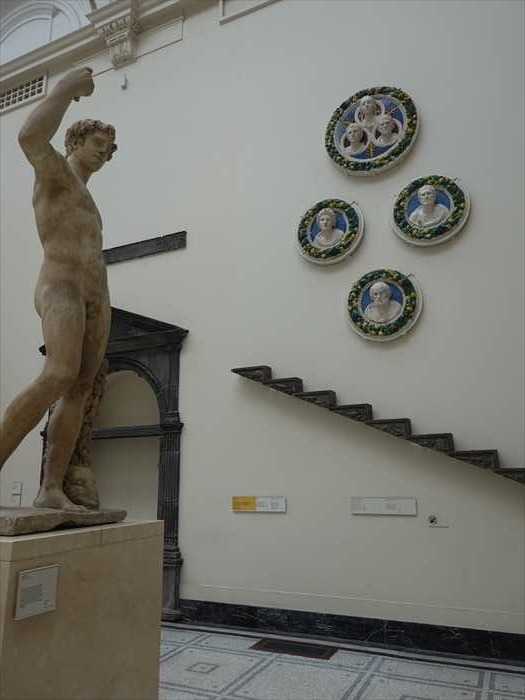
近づいて。

「 JASON
About 1550–1600
In the Renaissance, gardens were often associated with the earthly paradises of classical mythology. The story of Jason includes the sacred grove of the Golden Fleece and the
Garden of the Hesperides, making him a suitable subject for a garden. This sculpture
once stood in a portico in the garden of the Palazzo Stiozzi-Ridolfi in Florence.
Italy, Florence
Marble
Museum no. 6735-1860」
【 イアソン
制作年代:約1550–1600年
ルネサンス期において、庭園はしばしば古典神話における
地上の楽園と結びつけられました。イアソンの物語には、金羊毛の聖なる森やヘスペリデスの
園が含まれており、彼は庭園の主題としてふさわしい存在とされました。この彫像はかつて、
フィレンツェのストッツィ=リドルフィ宮殿の庭園の回廊に置かれていました。
イタリア、フィレンツェ
大理石館蔵番号:6735-1860】
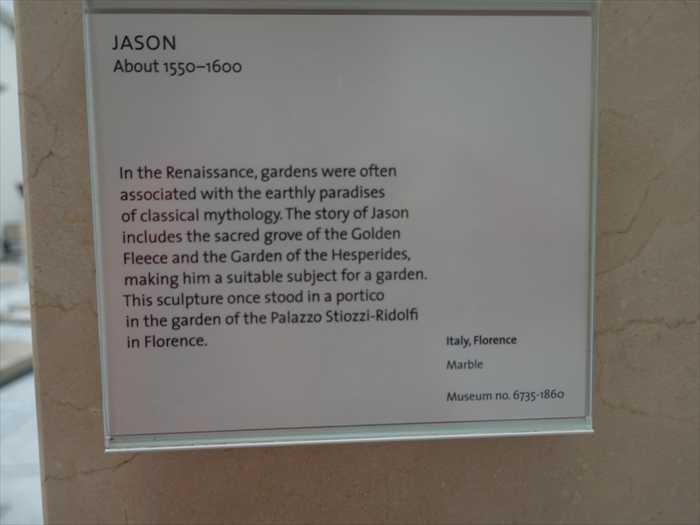
ナルキッソス(Narcissus)
・制作年代: 約1560年
・作者: ヴァレリオ・チョリ(Valerio Cioli, 1529–1599)による可能性
・材質: 大理石(19世紀に石膏で補修)
・出土地: イタリア(おそらくフィレンツェ)
・所蔵番号: Museum no. 7560-1861
移動して。

ズームして。

正面ホール(Grand Entrance Hall)の インフォメーション・デスク。
・手前:円形に近い大きなカウンターが設置され、スタッフが訪問者に案内やチケット情報を
提供。
提供。
・奥:正面玄関の大理石の柱列とガラス扉が見えます。ここからロンドンの Cromwell Road
(クロムウェル・ロード) 側に出入りします。
(クロムウェル・ロード) 側に出入りします。
・上部:先ほどの「チフーリのガラス・シャンデリア(Rotunda Chandelier)」が
吊るされているドーム空間の真下に位置。
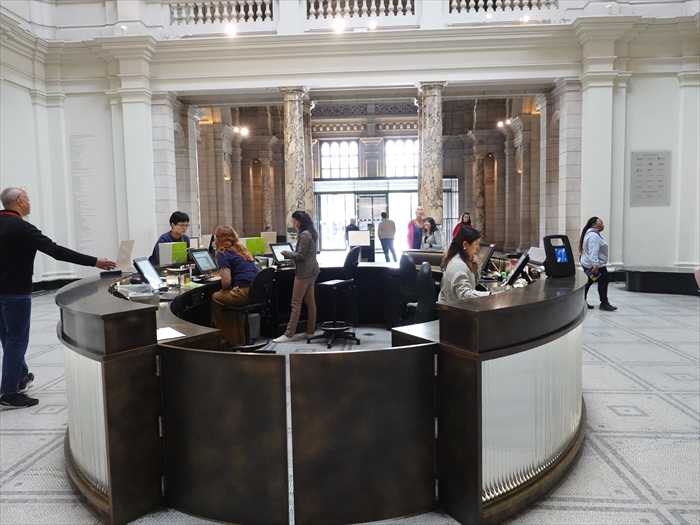
「Medieval and Renaissance(300–1500)」 の案内板が前方に。
4世紀に成立したキリスト教ローマ帝国からルネサンス期までの幅広い時代を網羅。

展示ギャラリーのひとつ、この後見学した
吊るされているドーム空間の真下に位置。

「Medieval and Renaissance(300–1500)」 の案内板が前方に。
4世紀に成立したキリスト教ローマ帝国からルネサンス期までの幅広い時代を網羅。

展示ギャラリーのひとつ、この後見学した
「Medieval and Renaissance(中世・ルネサンス 1350–1600)」ギャラリー の入口
付近。

「Medieval & Renaissance (1350–1600)」ギャラリー(50A–50D) の入口 標識。
・Medieval & Renaissance (1350–1600)
→ 中世後期からルネサンス時代(14世紀半ば〜16世紀)の作品を展示するエリア。
・50A–50D
→ この展示室の内部は、A〜Dの複数セクションに分けられており、時代・地域・テーマごとに
展示が整理されていた。

全景をネットから。
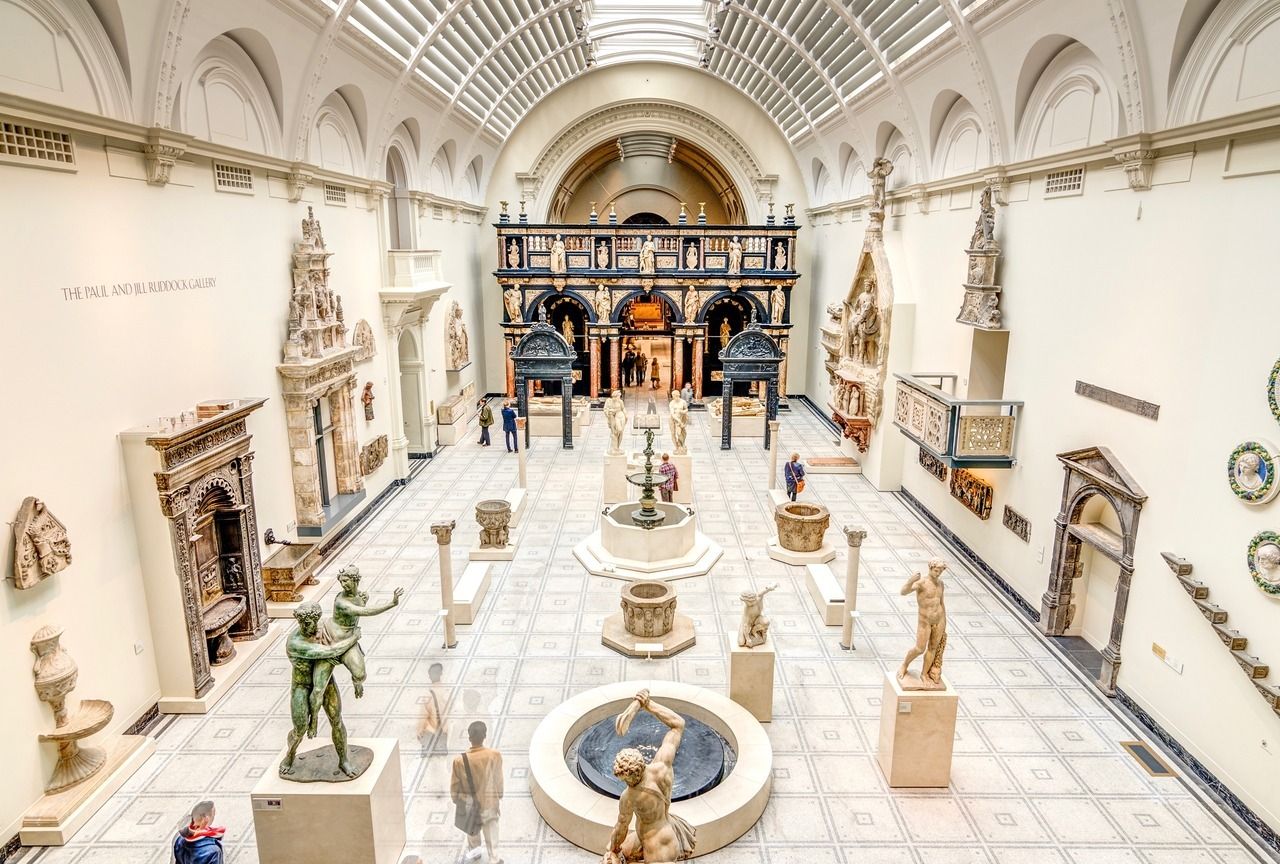
「Medieval & Renaissance Galleries (1350–1600)」の入口付近(Gallery 50A–50D) 。

移動そしてカメラ設定を変えて。

SAMSON SLAYING A PHILISTINE(ペリシテ人を打ち殺す サムソン )
展示が整理されていた。

全景をネットから。
ヴィクトリア&アルバート博物館(V&A) の
「Medieval & Renaissance Galleries (1350–1600)」 の中心ホールで、
正式には「The Paul and Jill Ruddock Gallery (Rooms 50A–50B)」と呼ばれる空間
。

「Medieval & Renaissance Galleries (1350–1600)」の入口付近(Gallery 50A–50D) 。
・天井が高く、ガラス屋根(barrel-vaulted skylight)が通る明るい空間。
・大理石床と、中央に大型彫刻を円形配置した構成。
・正面奥に黒い木製構造物(16世紀の聖堂の彫刻的内陣)があった。
・入口付近にはMedieval & Renaissance (1350–1600)(V&A所蔵オリジナル)を中央に配置。

移動そしてカメラ設定を変えて。

SAMSON SLAYING A PHILISTINE(ペリシテ人を打ち殺す サムソン )
・制作年:1562年頃
・作者:ジャンボローニャ(Giovanni Bologna, 通称 Giambologna, 1529–1608)
・材質:大理石
・所蔵:ヴィクトリア&アルバート博物館(V&A, ロンドン)

移動して。

移動して。

近づいて。
・ジャンボローニャが メディチ家のフランチェスコ1世・デ・メディチのために制作 した作品。
・これは彼の 最初の大規模な重要依頼作 であり、二人の人物を力強く絡み合わせ、複数の角度
から鑑賞できるよう設計されている。・当初はフィレンツェのフランチェスコ邸の薬草園の
噴水上に置かれていた。・1601年、外交贈答品としてスペインへ送られた経緯を持つ。
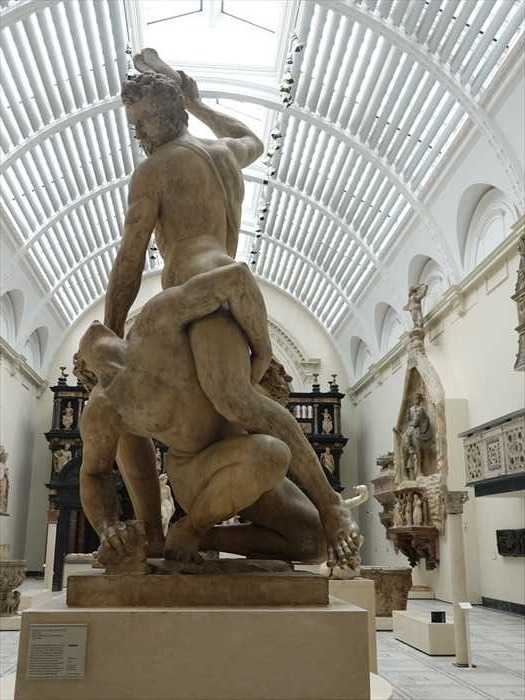
「 SAMSON SLAYING A PHILISTINE
【 サムソンがペリシテ人を打ち殺す

八角形の大理石製の 祭壇前飾り/洗礼盤(あるいは水盤) の一つ。
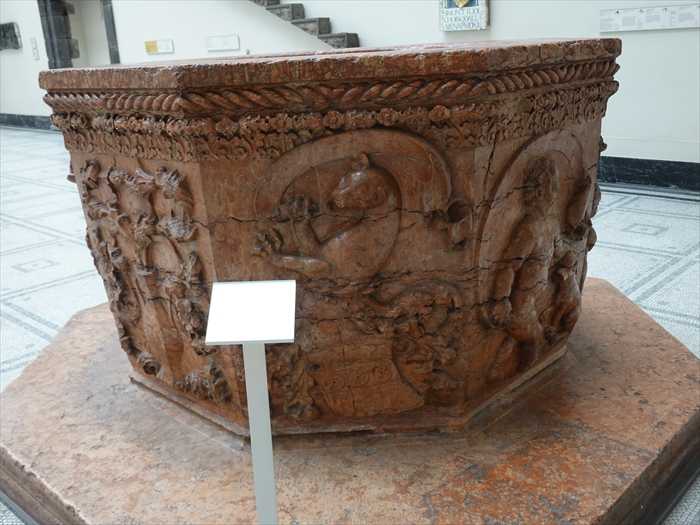
「WELL HEAD WITH THE ARMS OF THE CONCOREGGIO FAMILYWell heads were often
carved with the arms of the family that commissioned them, or – if public –
of the magistrate responsible for their construction. This richly decorated well head
probably stood in the courtyard of a private palace. It bears the arms of the
Concogreggio family – three wheels surmounted by a helmet.
Italy, VeronaLimestone,
known as Verona marbleGiven by Mr J.H. FitzhenryMuseum no. A.9-1909」
【この井戸枠は 「コンコレッジョ家の紋章を刻んだ井戸枠」 と呼ばれ、1450年頃に制作された
ものである。
J.H. フィッツヘンリー氏によって寄贈され、館蔵番号は A.9-1909 である。】
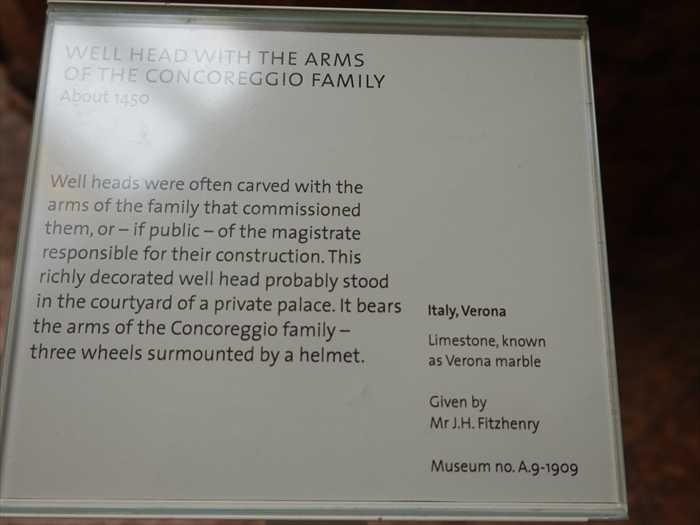
Well Head with the Arms of the Concogreggio Family

移動して。

移動して。

近づいて。
・ジャンボローニャが メディチ家のフランチェスコ1世・デ・メディチのために制作 した作品。
・これは彼の 最初の大規模な重要依頼作 であり、二人の人物を力強く絡み合わせ、複数の角度
から鑑賞できるよう設計されている。・当初はフィレンツェのフランチェスコ邸の薬草園の
噴水上に置かれていた。・1601年、外交贈答品としてスペインへ送られた経緯を持つ。

「 SAMSON SLAYING A PHILISTINE
About 1562
Giovanni Bologna, called Giambologna (1529–1608)
Giambologna, working at the court of the Medici grand-dukes of Tuscany, became
the most famous and influential sculptor of his day. This spectacular marble group,
made forFrancesco de’ Medici, was his first major commission. In it, he achieved his
ambition to create a two-figure group in movement, with several different viewpoints.
Originally placed atop a fountain in the herb garden of Francesco’s palace in Florence,
the group was sent to Spain in 1601 as a diplomatic gift.
the most famous and influential sculptor of his day. This spectacular marble group,
made forFrancesco de’ Medici, was his first major commission. In it, he achieved his
ambition to create a two-figure group in movement, with several different viewpoints.
Originally placed atop a fountain in the herb garden of Francesco’s palace in Florence,
the group was sent to Spain in 1601 as a diplomatic gift.
Marble
Purchased with the assistance of the Art Fund
Museum no. A.7-1954」 【 サムソンがペリシテ人を打ち殺す
約1562年
ジョヴァンニ・ボローニャ(ジャンボローニャ、1529–1608)
トスカーナのメディチ大公の宮廷で活動したジャンボローニャは、その時代で最も有名かつ
影響力のある彫刻家となった。この壮大な大理石群像は、フランチェスコ・デ・メディチの
ために制作されたもので、彼にとって最初の重要な依頼作である。作品において、彼は二人の
人物を動きの中で表現し、複数の異なる視点から鑑賞できる群像を作るという野心を実現した。
もともとはフィレンツェのフランチェスコ邸の薬草園の噴水の上に設置されていたが、
1601年に外交贈答品としてスペインへ送られた。
影響力のある彫刻家となった。この壮大な大理石群像は、フランチェスコ・デ・メディチの
ために制作されたもので、彼にとって最初の重要な依頼作である。作品において、彼は二人の
人物を動きの中で表現し、複数の異なる視点から鑑賞できる群像を作るという野心を実現した。
もともとはフィレンツェのフランチェスコ邸の薬草園の噴水の上に設置されていたが、
1601年に外交贈答品としてスペインへ送られた。
イタリア、フィレンツェ
大理石
アート・ファンドの協力により購入
館蔵番号 A.7-1954】
八角形の大理石製の 祭壇前飾り/洗礼盤(あるいは水盤) の一つ。

「WELL HEAD WITH THE ARMS OF THE CONCOREGGIO FAMILYWell heads were often
carved with the arms of the family that commissioned them, or – if public –
of the magistrate responsible for their construction. This richly decorated well head
probably stood in the courtyard of a private palace. It bears the arms of the
Concogreggio family – three wheels surmounted by a helmet.
Italy, VeronaLimestone,
known as Verona marbleGiven by Mr J.H. FitzhenryMuseum no. A.9-1909」
【この井戸枠は 「コンコレッジョ家の紋章を刻んだ井戸枠」 と呼ばれ、1450年頃に制作された
ものである。
井戸枠は、依頼した家の紋章で飾られることが多く、公共の井戸の場合は、その建設を監督した
行政官の紋章が刻まれることもあった。この豊かに装飾された井戸枠は、おそらく貴族の邸宅の
中庭に設置されていたと考えられる。そこには、兜の上に三つの車輪を配したコンコレッジョ家の
紋章が刻まれている。
イタリア、ヴェローナ製。素材はヴェローナ大理石として知られる石灰岩。行政官の紋章が刻まれることもあった。この豊かに装飾された井戸枠は、おそらく貴族の邸宅の
中庭に設置されていたと考えられる。そこには、兜の上に三つの車輪を配したコンコレッジョ家の
紋章が刻まれている。
J.H. フィッツヘンリー氏によって寄贈され、館蔵番号は A.9-1909 である。】

Well Head with the Arms of the Concogreggio Family
(コンコレッジョ家の紋章を刻んだ井戸枠)。
中世・ルネサンス ギャラリー(1350–1600に展示されている八角形の大理石製の祭壇前飾り/洗礼盤(あるいは水盤) の一つ。
・ 形状:
八角形の石槽(赤みを帯びた大理石)。
・ 装飾:
側面に浮彫で人物や場面が刻まれている。
・左側:衣をまとった人物群像。
・中央:馬上の騎士と思われる人物(円形のアーチで囲まれる)。
・右側:別の人物像が浮彫で表現。
・ 上縁:
ロープ文様のような連続模様。
1.洗礼盤(Baptismal font)
・教会の洗礼儀式に用いられる水槽。
・側面に聖書物語や寓意図像を刻むのが一般的。
2.説教壇(Pulpit)の一部
・ルネサンス期イタリアでしばしば八角形や多角形の構造が用いられた。
3.大理石製の祭壇前飾りや聖水盤(holy water stoup)
・聖堂入り口や側廊に置かれる場合もある。
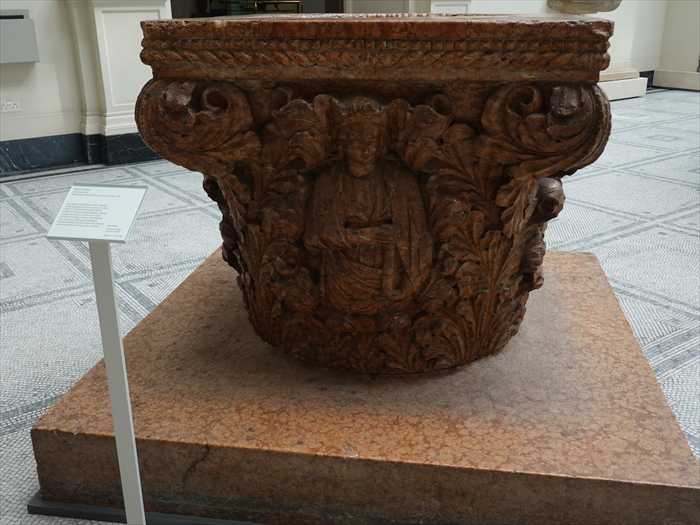
「 WELL HEAD About 1424–30Workshop of Bartolomeo Bon (active 1421–64)
This functional object is also a display of flamboyant virtuoso carving.
Its sides depict a shield with the arms of the Contarini family, Justice holding a sword,
a putto leaningon a tree trunk, and Fortitude holding a crown. Bartolomeo Bon had been previously employed by the wealthy merchant Marino Contarini on his sumptuous palace
,the Ca’ d’Oro.
Italy, VeniceLimestone, known as Verona marbleMuseum no. 1842-1892」
【井戸枠1424~1430年頃バルトロメオ・ボン工房(活動期間 1421–1464)この井戸枠は
実用的なものですが、同時に華麗な技巧を誇示する作品でもあります。側面にはコンタリーニ家の
紋章の盾、剣を持つ正義の寓意像、木の幹に寄りかかる幼児(プットー)、そして冠を持つ剛毅
(フォルティトゥード)の寓意像が彫られています。バルトロメオ・ボンは、以前に裕福な
商人マリーノ・コンタリーニによって、彼の壮麗な邸宅「カ・ドーロ宮殿」のために雇われた
ことがありました。
イタリア、ヴェネツィアヴェローナ大理石として知られる石灰岩館蔵番号 1842-1892】

「中世・ルネサンス(1350–1600)」ギャラリー の壁面展示。
【 モンドルフォのロッカ・ロヴェスカの壁柱コンソール

「中世・ルネサンス ギャラリー(1350–1600)」 の内部 。
・これらは15世紀フィレンツェの デッラ・ロッビア工房(Della Robbia family) による 
「 WELL HEAD About 1424–30Workshop of Bartolomeo Bon (active 1421–64)
This functional object is also a display of flamboyant virtuoso carving.
Its sides depict a shield with the arms of the Contarini family, Justice holding a sword,
a putto leaningon a tree trunk, and Fortitude holding a crown. Bartolomeo Bon had been previously employed by the wealthy merchant Marino Contarini on his sumptuous palace
,the Ca’ d’Oro.
Italy, VeniceLimestone, known as Verona marbleMuseum no. 1842-1892」
【井戸枠1424~1430年頃バルトロメオ・ボン工房(活動期間 1421–1464)この井戸枠は
実用的なものですが、同時に華麗な技巧を誇示する作品でもあります。側面にはコンタリーニ家の
紋章の盾、剣を持つ正義の寓意像、木の幹に寄りかかる幼児(プットー)、そして冠を持つ剛毅
(フォルティトゥード)の寓意像が彫られています。バルトロメオ・ボンは、以前に裕福な
商人マリーノ・コンタリーニによって、彼の壮麗な邸宅「カ・ドーロ宮殿」のために雇われた
ことがありました。
イタリア、ヴェネツィアヴェローナ大理石として知られる石灰岩館蔵番号 1842-1892】

「中世・ルネサンス(1350–1600)」ギャラリー の壁面展示。
・大きな円形陶板(中央上部)
緑と黄色が鮮やかな「マヨリカ焼き(イタリアのルネサンス陶器)」の円形飾り皿です。
中央には仮面(または盾のような顔面モチーフ)が描かれ、その周囲を葉模様や果実が
取り囲んでいます。これは16世紀イタリアで流行した装飾陶器の一例で、建物の外壁や
室内装飾に用いられました。
中央には仮面(または盾のような顔面モチーフ)が描かれ、その周囲を葉模様や果実が
取り囲んでいます。これは16世紀イタリアで流行した装飾陶器の一例で、建物の外壁や
室内装飾に用いられました。
・周囲の中小の円形/盾形装飾
盾(シールド)や紋章、装飾メダリオンの数々が並んでいます。これらはルネサンス期
イタリアの家紋装飾や建築装飾断片で、実際には宮殿や公的建築の壁を飾っていたものです。
家の権威を示したり、公共空間の荘厳さを高める目的がありました。
イタリアの家紋装飾や建築装飾断片で、実際には宮殿や公的建築の壁を飾っていたものです。
家の権威を示したり、公共空間の荘厳さを高める目的がありました。
・右側の鉄製ブラケット(ランプ台のような突き出し金具)
これは中世~ルネサンス期の建物で使われた鉄製の照明器具ホルダーで、壁に取り付け、
松明やランプを支えるために用いられました。
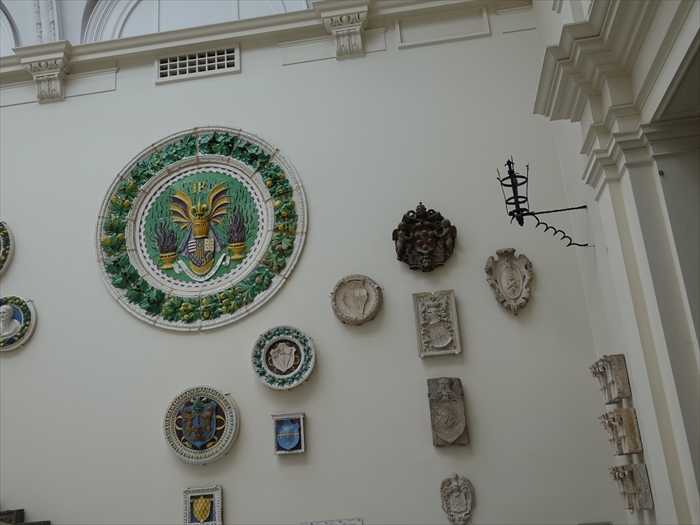
「 Istoriato Dish of Apollo
Giovanni de’ Medici (1475–1521) became Pope Leo X in 1513. His stemma is
composed of balls (palle), the heraldic device of the Medici family, surmounted
by the papal keysand tiara.」
【 アポロの物語を描いた飾り皿
紋章(ステンマ)
古典的頭像の円形装飾
教皇レオ10世の紋章(ステンマ)
1513–21年頃、フィレンツェで制作。錫釉陶器に多色で彩色。ジョヴァンニ・デ・メディチ
(1475–1521)は1513年に教皇レオ10世となり、その紋章はメディチ家の象徴である
「玉(パッレ)」に、教皇の鍵と三重冠(ティアラ)が組み合わされています。】
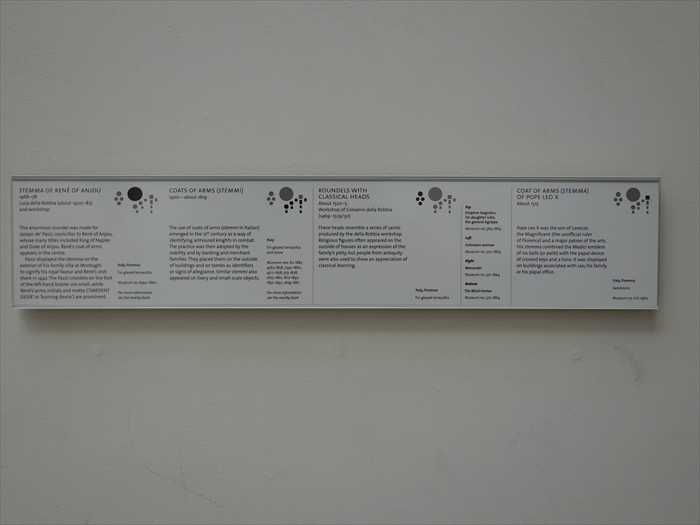
柱頭(キャピタル, capitals) 。
建築物の柱の最上部に置かれる装飾的要素で、
古代ギリシャ・ローマ建築以来、ロマネスク、ゴシック、ルネサンスなど様々な様式で発展した。
Museum no. 491-1871」 松明やランプを支えるために用いられました。

「 Istoriato Dish of Apollo
About 1532–35
Nicola da Urbino (active 1520s–30s)
Tin-glazed earthenware, painted in polychrome, with gilding
Italy, Urbino
Museum no. 1716–1855
The story of Apollo slaying Niobe’s children is told on this dish. According to Ovid’s Metamorphoses, Apollo and Diana killed Niobe’s 12 children after she insulted their
mother Latona (Leto). The reverse has grotesques, including winged female masks.
mother Latona (Leto). The reverse has grotesques, including winged female masks.
Given by Mr John Webb
Coats of Arms (stemma)
The coat of arms of a family was a symbol of their identity and authority. They were
displayed on a wide range of objects, from buildings to domestic items. On ceramics,
arms often proclaimed the ownership of a piece, its association with a particular family,
or its status as a diplomatic gift.
displayed on a wide range of objects, from buildings to domestic items. On ceramics,
arms often proclaimed the ownership of a piece, its association with a particular family,
or its status as a diplomatic gift.
Roundels with Classical Heads
Italy, about 1475–1500
Tin-glazed earthenware, painted in blue, green, yellow and manganese
Florence or Faenza
Museum no. C.218–1922, C.220–1922
Displaying the heads of heroes of antiquity was an important feature of Renaissance
decoration. These roundels are part of a group that was made in imitation of
antiquecameos. Their designs were probably based on medals, which were often
set intopalace walls.
decoration. These roundels are part of a group that was made in imitation of
antiquecameos. Their designs were probably based on medals, which were often
set intopalace walls.
Coat of Arms (stemma) of Pope Leo X
Italy, Florence, about 1513–21
Tin-glazed earthenware, painted in polychrome
Museum no. 8124–1863
Giovanni de’ Medici (1475–1521) became Pope Leo X in 1513. His stemma is
composed of balls (palle), the heraldic device of the Medici family, surmounted
by the papal keysand tiara.」
【 アポロの物語を描いた飾り皿
1532–35年頃、ニコラ・ダ・ウルビーノ作。錫釉陶器に多色彩と金彩で描かれた作品で、
イタリアのウルビーノで制作されました。オウィディウス『変身物語』に基づき、
アポロとディアナがニオベの母ラトーナ(レト)を侮辱したために、彼女の12人の子どもを
殺した場面が表されています。裏面には翼のある女性の仮面を含むグロテスク文様が描かれています。
イタリアのウルビーノで制作されました。オウィディウス『変身物語』に基づき、
アポロとディアナがニオベの母ラトーナ(レト)を侮辱したために、彼女の12人の子どもを
殺した場面が表されています。裏面には翼のある女性の仮面を含むグロテスク文様が描かれています。
紋章(ステンマ)
家族の紋章は、その一族の身分や権威を示す象徴でした。建築物から日用品に至るまで広く
用いられ、陶器の装飾では所有者やその家族との結びつきを示したり、外交的贈り物としての
性格を持つ場合もありました。
用いられ、陶器の装飾では所有者やその家族との結びつきを示したり、外交的贈り物としての
性格を持つ場合もありました。
古典的頭像の円形装飾
1475–1500年頃、フィレンツェまたはファエンツァで制作。錫釉陶器に青、緑、黄、
マンガン色で彩色されています。古代の英雄の頭部を表すことはルネサンス装飾の重要な
特徴でした。これらの円形装飾は、古代のカメオを模倣して作られた一群の作品で、
その図像はしばしば宮殿の壁に埋め込まれたメダルをもとにしています。
マンガン色で彩色されています。古代の英雄の頭部を表すことはルネサンス装飾の重要な
特徴でした。これらの円形装飾は、古代のカメオを模倣して作られた一群の作品で、
その図像はしばしば宮殿の壁に埋め込まれたメダルをもとにしています。
教皇レオ10世の紋章(ステンマ)
(1475–1521)は1513年に教皇レオ10世となり、その紋章はメディチ家の象徴である
「玉(パッレ)」に、教皇の鍵と三重冠(ティアラ)が組み合わされています。】

柱頭(キャピタル, capitals) 。
建築物の柱の最上部に置かれる装飾的要素で、
古代ギリシャ・ローマ建築以来、ロマネスク、ゴシック、ルネサンスなど様々な様式で発展した。
・6点(左右3列×2段)に並べられた石製の柱頭断片。
・植物文様(アカンサス葉、花飾り)が中心的モチーフ。
・渦巻き(ヴォリュート)を持つものもあり、イオニア式やコリント式の系譜を示唆。
・中央列のものには、楽器のような格子文様や、盾・武器のような意匠も見える。
・元来は建物の一部として高所に据えられ、構造と装飾を兼ねた役割を果たしていました。

上のプレート。
「 STREET CRESSET

上のプレート。
「 STREET CRESSET
1500–1600
The earliest recorded street lights took the form of decorative iron baskets, known as
cressets, which were fixed to the walls of Italian palaces. The light came from burning
coils of rope soaked in pitch and placed in the cradle. These lanterns were almost
exclusively used in Italy.
cressets, which were fixed to the walls of Italian palaces. The light came from burning
coils of rope soaked in pitch and placed in the cradle. These lanterns were almost
exclusively used in Italy.
Italy, Florence
Wrought iron
Museum no. 734-1869」
【 街路用クレセット(かご型照明)
【 街路用クレセット(かご型照明)
1500–1600年
最も初期に記録された街灯は、装飾的な鉄製のかごの形をしており、「クレセット」と呼ばれ、
イタリアの宮殿の壁に取り付けられていました。光は、ピッチ(樹脂)に浸した縄のコイルを
燃やし、かごの中に置くことで得られました。これらのランタンは、ほぼイタリアだけで使用
されていました。
イタリアの宮殿の壁に取り付けられていました。光は、ピッチ(樹脂)に浸した縄のコイルを
燃やし、かごの中に置くことで得られました。これらのランタンは、ほぼイタリアだけで使用
されていました。
イタリア、フィレンツェ
鍛鉄
館蔵番号 734-1869】
下のプレート。
「 PILASTER CONSOLES FROM THE ROCCA ROVESCAS DI MONDOLFO
1462–1480
Probably by Francesco di Giorgio Martini (1439–1502) and workshop
These consoles,with acanthus leaves and other Renaissance decoration, came from
a fort on theAdriatic coast. The fort was commissioned by Giovanni della Rovere,
Duke of Sora,Lord of Senigallia and nephew of Pope Sixtus IV.
Italy, Senigallia(Marche)
Verona marble
下のプレート。
「 PILASTER CONSOLES FROM THE ROCCA ROVESCAS DI MONDOLFO
1462–1480
Probably by Francesco di Giorgio Martini (1439–1502) and workshop
These consoles,with acanthus leaves and other Renaissance decoration, came from
a fort on theAdriatic coast. The fort was commissioned by Giovanni della Rovere,
Duke of Sora,Lord of Senigallia and nephew of Pope Sixtus IV.
Italy, Senigallia(Marche)
Verona marble
【 モンドルフォのロッカ・ロヴェスカの壁柱コンソール
1462–1480年
おそらくフランチェスコ・ディ・ジョルジョ・マルティーニ(1439–1502)とその工房による。
このコンソール(持ち送り装飾)は、アカンサスの葉やその他ルネサンス装飾が施されており、
アドリア海沿岸の要塞から来たものです。その要塞は、ソーラ公でセニガッリア領主、
そして教皇シクストゥス4世の甥であったジョヴァンニ・デッラ・ローヴェレによって
建設されました。
アドリア海沿岸の要塞から来たものです。その要塞は、ソーラ公でセニガッリア領主、
そして教皇シクストゥス4世の甥であったジョヴァンニ・デッラ・ローヴェレによって
建設されました。
イタリア、セニガッリア(マルケ州)
ヴェローナ大理石
館蔵番号 491-1871】
「中世・ルネサンス ギャラリー(1350–1600)」 の内部 。
1.中央の立像
ギリシャ・ローマ彫刻を模した男性裸体像が中心に置かれています。片手を上げ、古典的な
英雄像のポーズを示しています。
英雄像のポーズを示しています。
2.奥の黒い構造物
写真奥に見える大きな黒い構造は、ルネサンス期イタリアの教会や宮殿の建築要素を
移設したもの(またはレプリカ) で、壁面いっぱいに彫刻やアーチを備えた荘厳な展示です。
移設したもの(またはレプリカ) で、壁面いっぱいに彫刻やアーチを備えた荘厳な展示です。
3.手前の円形井戸枠(Well Head)
写真左下に円形の石造「井戸枠」が見えます。先ほど解説した「Well Head(井戸枠)」に
関連する展示の一つです。中庭の装飾品であり、貴族の邸宅や宮殿に設置されていたもの。
関連する展示の一つです。中庭の装飾品であり、貴族の邸宅や宮殿に設置されていたもの。
4.壁面装飾と彫刻群
左壁には祭壇建築の一部や、墓碑的な建築彫刻、また上段には盾や装飾レリーフが取り
付けられています。
付けられています。
5.ギャラリーの雰囲気
白を基調とした空間に、明るい天窓(ヴォールト型のトップライト)が特徴的で、展示作品を
自然光で照らし出しています。
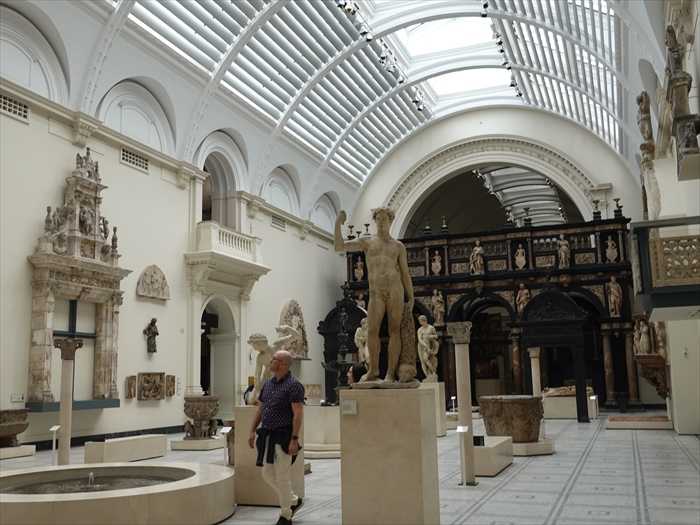
左側の壁にあった「 Window surround(窓枠) 」。
これは、ルネサンス様式の大理石製建築装飾(彫刻付窓枠または暖炉飾り)で、16世紀中期
イタリアの芸術を代表する作品群に見られる構成。
構造と装飾の特徴から、ヴェネツィア派または北イタリアのマニエリスム建築彫刻に属するもの
と考えられる と。

「 サビニの女の略奪(The Rape of a Sabine Woman) 」のブロンズ複製。
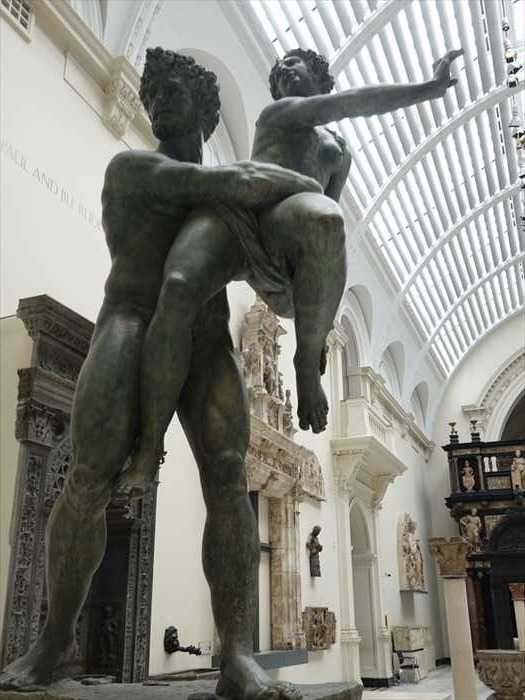
「 THE RAPE OF PROSERPINA
About 1565
Probably based on a model by Vincenzo de’ Rossi (1525–87)
This dramatic sculpture shows Pluto, the king of the underworld,
carrying off Proserpina with whom he had fallen in love. It originally belonged to
Giovan Vittorio Soderini, a leading exponent of garden design in 16th-century Florence.
In promoting the use of sculpture and fountains, Soderini described water as the soul of
cities and gardens. In 1594 the bronze group was sold to Antonio Salviati, who placed it
on an elaborate fountain in his palace garden (see photo).Italy, FlorenceBronze Cast by
Raffaello PeriLent by the National TrustPen and ink drawing with monochrome wash,
probably by Ferdinando Ruggieri (1691–1741)V&A: E.571-1975」
【 プロセルピナの略奪
約1565年
おそらくヴィンチェンツォ・デ・ロッシ(1525–1587)の原型に基づく作品
この劇的な彫刻は、冥界の王プルート(ハーデース)が恋に落ちたプロセルピナをさらう場面を
表しています。もともとは16世紀フィレンツェの庭園設計の第一人者であったジョヴァン・
ヴィットリオ・ソデリーニの所蔵でした。ソデリーニは彫刻や噴水の使用を推奨し、水を都市と
庭園の魂であると表現しました。1594年、このブロンズ群像はアントニオ・サルヴィアーティに
売却され、彼の宮殿庭園にある精巧な噴水の上に設置されました(写真参照)。
イタリア、フィレンツェ
ブロンズ
鋳造:ラファエロ・ペリ
ナショナル・トラスト寄託
ペンとインクに単色の彩色を施した素描、おそらくフェルディナンド・ルッジェーリ
(1691–1741)による
V&A: E.571-1975】
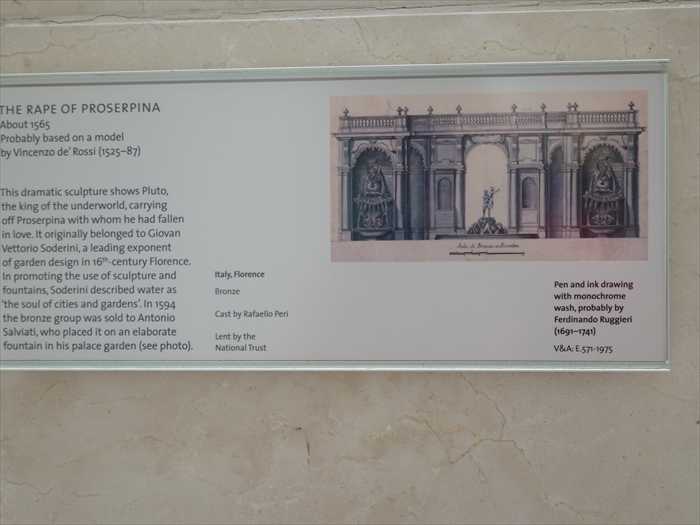
手前の彫像は JASON像 。
・壁面の円形装飾(右側)
・ドーナツ型の緑と黄色の装飾で縁取られた「彩色テラコッタの円形メダリオン」作品群です。 自然光で照らし出しています。

左側の壁にあった「 Window surround(窓枠) 」。
これは、ルネサンス様式の大理石製建築装飾(彫刻付窓枠または暖炉飾り)で、16世紀中期
イタリアの芸術を代表する作品群に見られる構成。
構造と装飾の特徴から、ヴェネツィア派または北イタリアのマニエリスム建築彫刻に属するもの
と考えられる と。
・作品名(英)Architectural window surround
・推定製作地フィレンツェまたはルッカ(イタリア)
・年代 約1550年頃(16世紀中期)
・材質 大理石(carved marble)
・寸法 高さ 約4.5メートル(実物大建築要素)
・所蔵 Victoria and Albert Museum, London(Museum no. A.3-1912)

「 サビニの女の略奪(The Rape of a Sabine Woman) 」のブロンズ複製。

「 THE RAPE OF PROSERPINA
About 1565
Probably based on a model by Vincenzo de’ Rossi (1525–87)
This dramatic sculpture shows Pluto, the king of the underworld,
carrying off Proserpina with whom he had fallen in love. It originally belonged to
Giovan Vittorio Soderini, a leading exponent of garden design in 16th-century Florence.
In promoting the use of sculpture and fountains, Soderini described water as the soul of
cities and gardens. In 1594 the bronze group was sold to Antonio Salviati, who placed it
on an elaborate fountain in his palace garden (see photo).Italy, FlorenceBronze Cast by
Raffaello PeriLent by the National TrustPen and ink drawing with monochrome wash,
probably by Ferdinando Ruggieri (1691–1741)V&A: E.571-1975」
【 プロセルピナの略奪
約1565年
おそらくヴィンチェンツォ・デ・ロッシ(1525–1587)の原型に基づく作品
この劇的な彫刻は、冥界の王プルート(ハーデース)が恋に落ちたプロセルピナをさらう場面を
表しています。もともとは16世紀フィレンツェの庭園設計の第一人者であったジョヴァン・
ヴィットリオ・ソデリーニの所蔵でした。ソデリーニは彫刻や噴水の使用を推奨し、水を都市と
庭園の魂であると表現しました。1594年、このブロンズ群像はアントニオ・サルヴィアーティに
売却され、彼の宮殿庭園にある精巧な噴水の上に設置されました(写真参照)。
イタリア、フィレンツェ
ブロンズ
鋳造:ラファエロ・ペリ
ナショナル・トラスト寄託
ペンとインクに単色の彩色を施した素描、おそらくフェルディナンド・ルッジェーリ
(1691–1741)による
V&A: E.571-1975】

手前の彫像は JASON像 。
・壁面の円形装飾(右側)
代表的な装飾技法「グレーズ陶(glazed terracotta)」で作られたものです。
・人物胸像が浮き彫りで描かれ、聖人や貴族を表していることが多いです。

近づいて。

「 JASON
About 1550–1600
In the Renaissance, gardens were often associated with the earthly paradises of classical mythology. The story of Jason includes the sacred grove of the Golden Fleece and the
Garden of the Hesperides, making him a suitable subject for a garden. This sculpture
once stood in a portico in the garden of the Palazzo Stiozzi-Ridolfi in Florence.
Italy, Florence
Marble
Museum no. 6735-1860」
【 イアソン
制作年代:約1550–1600年
ルネサンス期において、庭園はしばしば古典神話における
地上の楽園と結びつけられました。イアソンの物語には、金羊毛の聖なる森やヘスペリデスの
園が含まれており、彼は庭園の主題としてふさわしい存在とされました。この彫像はかつて、
フィレンツェのストッツィ=リドルフィ宮殿の庭園の回廊に置かれていました。
イタリア、フィレンツェ
大理石館蔵番号:6735-1860】

ナルキッソス(Narcissus)
・制作年代: 約1560年
・材質: 大理石(19世紀に石膏で補修)

「 NARCISSUS
About 1560
Possibly by Valerio Cioli (about 1529–99)
During the Renaissance, it was a common practice to re-work ancient Roman sculpture.
Narcissus was long thought to be an example of this, but instead it was possibly made
by a sculptor and restorer called Valerio Cioli. A Greek myth tells how Narcissus
fell in love with his reflection in a pool. This made him a suitable subject for garden
sculpture.Italy, probably Florence
Narcissus was long thought to be an example of this, but instead it was possibly made
by a sculptor and restorer called Valerio Cioli. A Greek myth tells how Narcissus
fell in love with his reflection in a pool. This made him a suitable subject for garden
sculpture.Italy, probably Florence
Marble
With 19th-century plaster repairs
Museum no. 7560-1861 」 【 ナルキッソス
約1560年
ヴァレリオ・チョリ(1529–1599頃)作の可能性
ルネサンス期には、古代ローマの彫刻を再加工することがよく行われました。
この像《ナルキッソス》も長らくその一例と考えられていましたが、現在では彫刻家で修復家でも
あったヴァレリオ・チョリによって制作された可能性があるとされています。
ギリシャ神話によれば、ナルキッソスは水面に映る自分の姿に恋をしたと伝えられています。
この神話は庭園彫刻の題材として非常にふさわしいものでした。
イタリア(おそらくフィレンツェ)
大理石
19世紀に石膏による修復あり
館蔵番号 7560-1861 】

・・・ もどる ・・・
・・・ つづく ・・・
お気に入りの記事を「いいね!」で応援しよう
【毎日開催】
15記事にいいね!で1ポイント
10秒滞在
いいね!
--
/
--
© Rakuten Group, Inc.










